Macrosphenidae
| African warblers | |
|---|---|

| |
| Cape grassbird Sphenoeacus afer | |
| Scientific classification | |
| Domain: | Eukaryota |
| Kingdom: | Animalia |
| Phylum: | Chordata |
| Class: | Aves |
| Order: | Passeriformes |
| Superfamily: | Sylvioidea |
| Family: | Macrosphenidae Wolters, 1983 |
| Genera | |
|
See text | |
The African warblers are a newly erected
Taxonomy
The family name (as the subfamily Macrospheninae) was introduced by the German ornithologist Hans Wolters in 1983 but was not formally defined until 2012.[3][4][5] The family contains 18 species divided into 6 genera.[6]
The genus level phylogeny shown below is based on a genetic study by Silke Fregin and collaborators that was published in 2012. The rockrunner Achaetops pycnopygius was not included in the study.[5]
| Macrosphenidae |
| ||||||||||||||||||||||||
Distribution and habitat
The African warblers inhabit a range of habitats in sub-Saharan Africa. These range from primary rainforest to forest edge and open woodland habitats for the longbills, wooded savanna to arid scrubland and bushland in the crombecs, rocky arid scree areas and grassland for the rockrunner, and grassland for the moustached grass warbler and Cape grassbird. The family is overwhelmingly non-migratory, although the moustached grass warbler and the northern crombec both make some localised movements in West Africa related to the rainy season.[7]
Description
The African warblers range in size from the smaller crombecs, which measure 8 cm (3.1 in) in length and weigh as little as 6.5 g (0.23 oz), to the Cape grassbird, which measures 19–23 cm (7.5–9.1 in) in length and the moustached grass warbler which weighs 29–40 g (1.0–1.4 oz). There is considerable difference in appearance between the genera; for example, the two grass warblers and Victorin's warbler possess long graduated tails, whereas the crombecs have tails which barely extend beyond the tail coverts and folded wings.[7]
Behaviour
The African warblers are insect eaters, and take a range of insect prey. The longbills and crombecs feed in the canopy and in bushes, either as singles or pairs and sometimes in small groups, whereas the other species are more terrestrial in their habits. Where two species co-occur, such as the red-faced crombec and the long-billed crombec over parts of their range,
Breeding is seasonal and usually timed to coincide with the end of the dry season and beginning of the rainy season; in species with large ranges this can lead to considerable variation as to the exact timing. Information is lacking in many species, but for those that have been studied the African warblers are territorial and monogamous. Nest design varies within the family; the crombecs construct deep pocket-shaped nests suspended from a branch; whereas the Victorin's warbler, Cape grassbird and moustached grass warbler construct cup nests weaved from grass.[7]
Status and conservation
The majority of this family are considered to be fairly secure and are listed by the
Species

- Genus Sylvietta– crombecs
- Green crombec, Sylvietta virens
- Lemon-bellied crombec, Sylvietta denti
- White-browed crombec, Sylvietta leucophrys
- extinct(late 20th century?)
- Northern crombec, Sylvietta brachyura
- Philippa's crombec, Sylvietta philippae
- Red-capped crombec, Sylvietta ruficapilla
- Red-faced crombec, Sylvietta whytii
- Somali crombec, Sylvietta isabellina
- Long-billed crombec, Sylvietta rufescens
- Genus Melocichla
- Moustached grass warbler, Melocichla mentalis
- Genus Achaetops
- Rockrunner, Achaetops pycnopygius
- Genus Sphenoeacus
- Cape grassbird, Sphenoeacus afer
- Genus Cryptillas – formerly Bradypterus (now Locustellidae)
- Victorin's warbler, Cryptillas victorini
- Genus Macrosphenus – longbills
- Kemp's longbill, Macrosphenus kempi
- Yellow longbill, Macrosphenus flavicans
- Grey longbill, Macrosphenus concolor
- Pulitzer's longbill, Macrosphenus pulitzeri
- Kretschmer's longbill, Macrosphenus kretschmeri
References
- PMID 15888418.
- PMID 18619860.
- ISBN 978-3-922465-04-1.
- hdl:2246/830.
- ^ PMID 22920688.
- Rasmussen, Pamela, eds. (January 2023). "Cupwings, crombecs, cettiid bush warblers, Streaked Scrub Warbler, yellow flycatchers, hylias". IOC World Bird List Version 13.1. International Ornithologists' Union. Retrieved 23 May 2023.
- ^ ISBN 84-96553-06-X.
